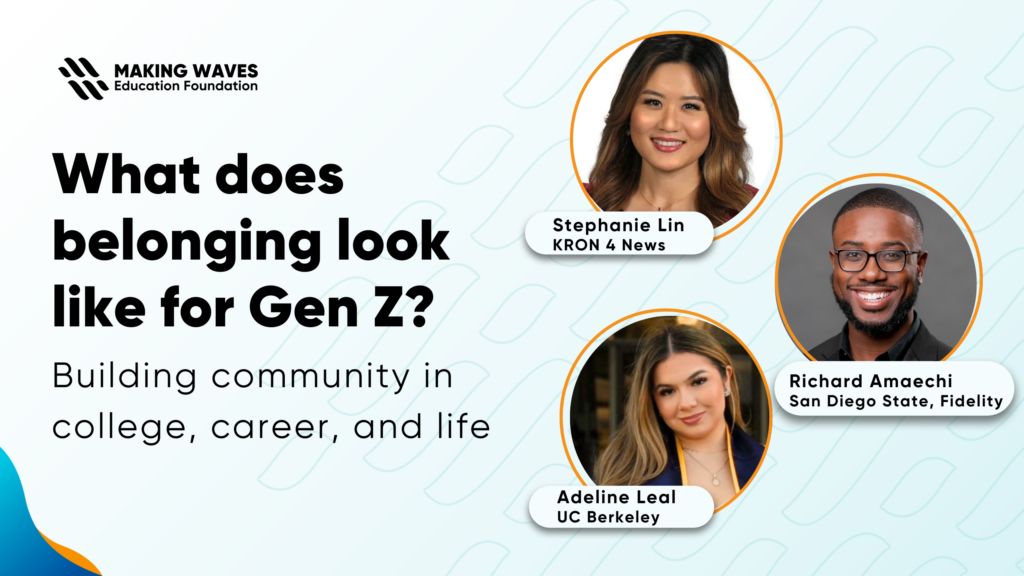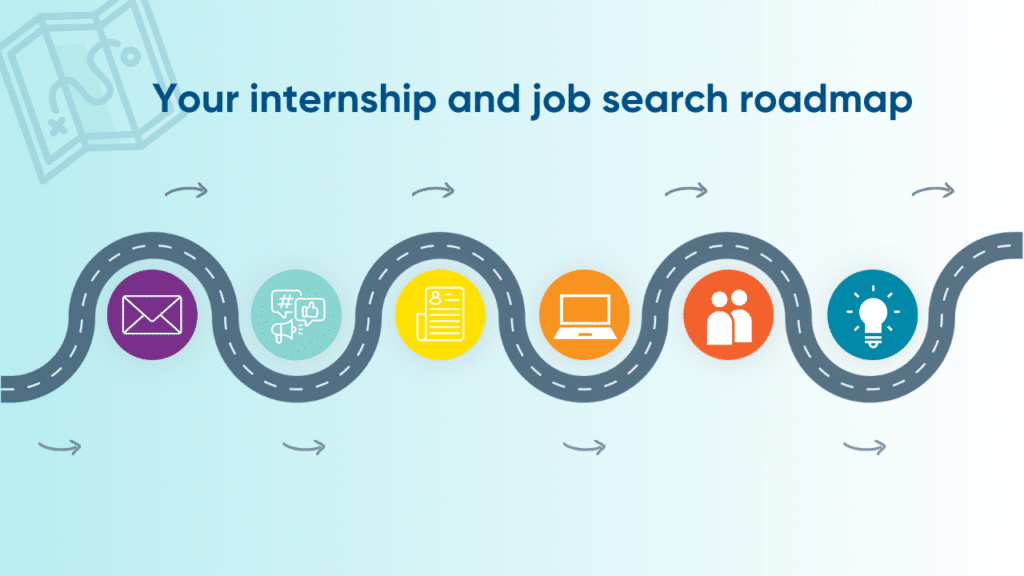
Job and internship search 101: Your roadmap to prepare, strategize, and land the job
Internships provide valuable resume-building experience, help your confidence, and help you land a job after college graduation. Still not convinced you need an internship? Here are the eight reasons to get internships during college.
Now you might be thinking, “where do I start?” This resource contains the steps to prepare, strategize, and carry out your internship or job search plan.
| Skip directly to: |
|---|
| 🔗 The hiring cycle and timeline |
| 🔗 The preparation |
| 🔗 The strategy |
| 🔗 Tips for your search |
| 🔗 More resources |
| 🔗 We’re here to help! |
The hiring cycle and timeline
A critical step to take before you even begin preparing for your internship or job search is familiarizing yourself with the typical hiring timeline for internships and new grad jobs. This can help with creating your own plan.
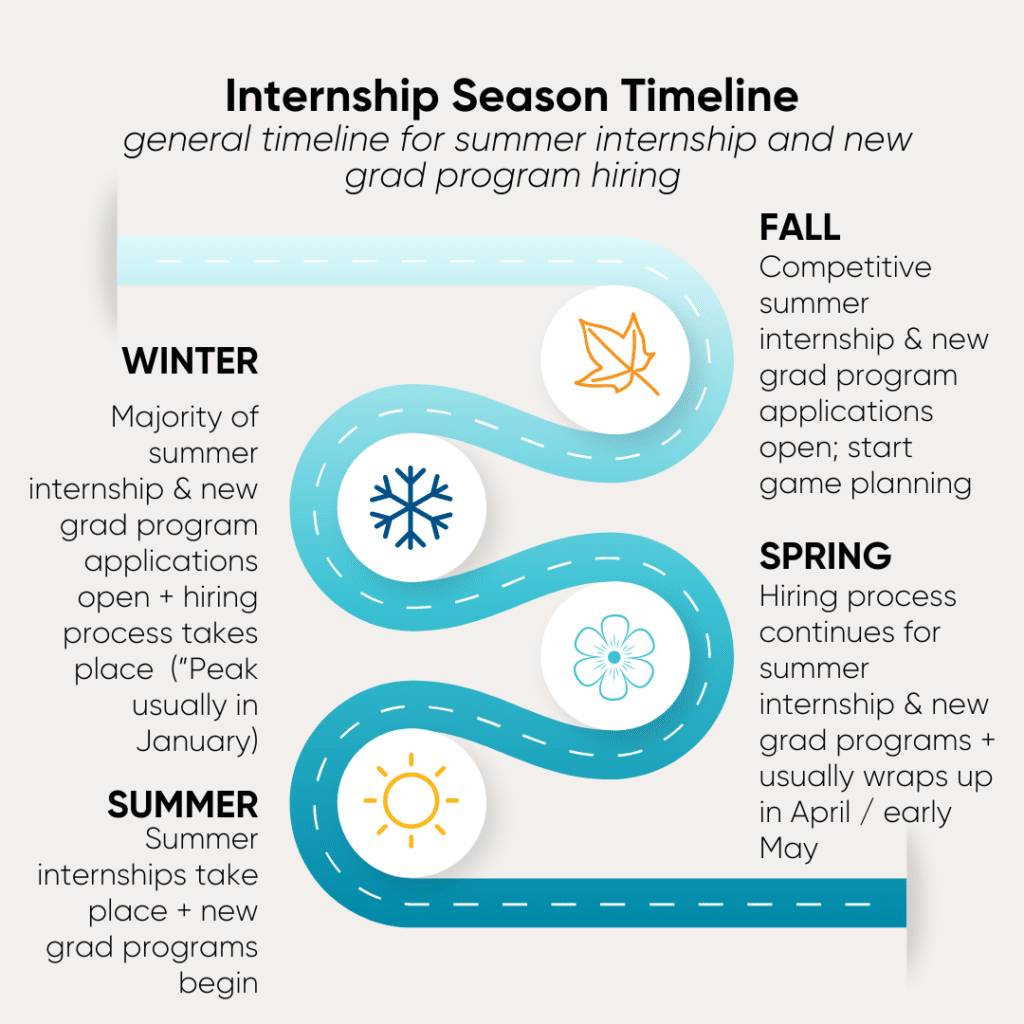
🍁 Five steps you can take this fall to prepare
Fall is typically when competitive summer internships and new grad program applications open. This is common in finance, consulting, and some tech and entertainment industries. For example: Uber | Salesforce | Figma | Intel | JPMC | Morgan Stanley | Deloitte | Price Waterhouse Cooper | Disney | Warner Brothers
Here are some steps to take:
- Reflect on types of opportunities you want to apply to that align with your career goals.
- Update your resume and LinkedIn profile.
- Get feedback from trusted advisor like your Making Waves college coach, from the Making Waves early career team, or from your college’s career center.
- Sign up for notifications and follow companies so you know when their applications open. This could be on their website, LinkedIn, and other social media accounts.
- Start applying and/or make a game plan for how and when you’ll start applying. Plan for how you’ll remain organized.
❄️ Five steps you can take this winter to prepare
The majority of summer internship and new grad program applications open in the winter and the hiring process takes place during this time. ”Peak” internship application season is usually in January.
Here are some steps to take:
- Start searching and applying! Put your internship/job search plan into action!
- Target application materials for each opportunity using targeted resumes and cover letters.
- Reach out to potential references and get them up to speed on types of opportunities you’re applying for.
- Practice your interview skills. Ask to do mock interview with your Making Waves college coach, your peers, or your campus career center.
- Network by attending career fairs, networking events, and informational interviews.
🌸 Five steps you can take this spring to prepare
In the spring, the hiring process continues for summer internships and new graduate programs. Interviews and hiring usually wrap up around April or May.
Here are some steps to take:
- Keep applying and interviewing!
- Continue practicing your interviewing skills.
- Consider job and internship offers. Weigh pros and cons and your priorities to make decisions. Don’t burn bridges – follow up with and thank those who are a part of the interview process.
- Broaden the scope of your search if you haven’t landed an internship/job. consider other industries or positions that could still align with your career goals.
- Consider “Plan B” if internships aren’t working out; there’s many alternative ways to gain valuable experience/skills!
⏰ Other key milestones in the hiring cycle
- Many competitive opportunities will open their applications as early as August and September for positions that start in the following summer.
- The majority of internship and new grad program hiring across industries ramps up between November and “peaks” in January.
- The next wave of hiring typically picks up again in March. This is usually the last push to land an internship and new grad programs and positions.
The job and internship search preparation
Before you dive into your job or internship search, start here. Think of this as housekeeping. It’s a great practice to go through these steps every year ahead of applying to new opportunities.
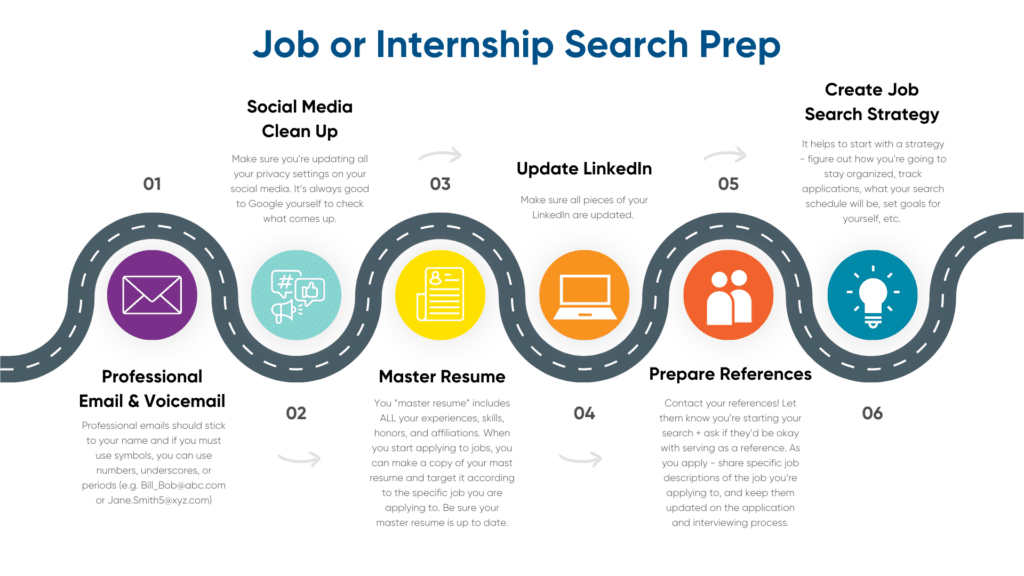
1. Set up a professional email and voicemail
When creating a professional email or voicemail, keep it simple. For additional information check out:
2. Do a social media clean up
According to The Muse, 45% of hiring managers use social media to learn about potential candidates. It’s important to be mindful of your social media presence, and ensure that information you want to keep private remains that way. For ideas on how to clean up your social media, check out this article.
3. Create a master resume
A master resume includes all your experiences, skills, honors, and affiliations. It’s like a running log of your professional journey that can be used as a foundation when creating a targeted resume. A way to prepare before applying to internships and jobs is to take time to create or update your master resume. Be sure to build your master resume in accordance to resume formatting and content expectations. This will make it easier for you when targeting application materials.
Here are some resources for you:
| Resume tools and templates |
|---|
| 🔗 Resume Template (WORD DOC) |
| 🔗 AI RESUME BUILDER TOOL (URL) |
| 🔗 Resume Review Checklist (INTERACTIVE PDF) |
| 🔗 Step by step resume set up guide (URL) |
| 🔗 Resume Formatting for ATS (PDF) |
| 🔗 Resume Handbook (PDF) |
4. Update your LinkedIn
Similar to your resume, it’s important to update your LinkedIn. According to Zippia, 94% of recruiters use LinkedIn to vet candidates.
Refer to these resources to help set up or create your LinkedIn profile:
| LinkedIn tips and tricks |
|---|
| 🔗 Setting Up Your LinkedIn Profile – The Basics (PDF) |
| 🔗 Basic LinkedIn Profile Checklist (PDF) |
| 🔗 Setting Up Your LinkedIn Profile – Advanced (PDF) |
5. Prepare your references
Before you begin applying, it’s important to brainstorm who you would potentially ask to serve as your reference.
Once you have 3-4 people in mind, it’s best practice to ask for their permission and keep them in the loop throughout your application process, especially if/when you begin interviewing for a position. For more details, see this article: How to ask someone to be your reference with email examples.
6. Create your job search strategy
Though you can apply to opportunities as they come, it’s most advantageous to create a strategy first. This can help you get organized, set goals, and stick to a schedule. For more on this, check the next section.
The job and internship search strategy
Before you begin applying for internships or new grad job, we suggest addressing these steps.
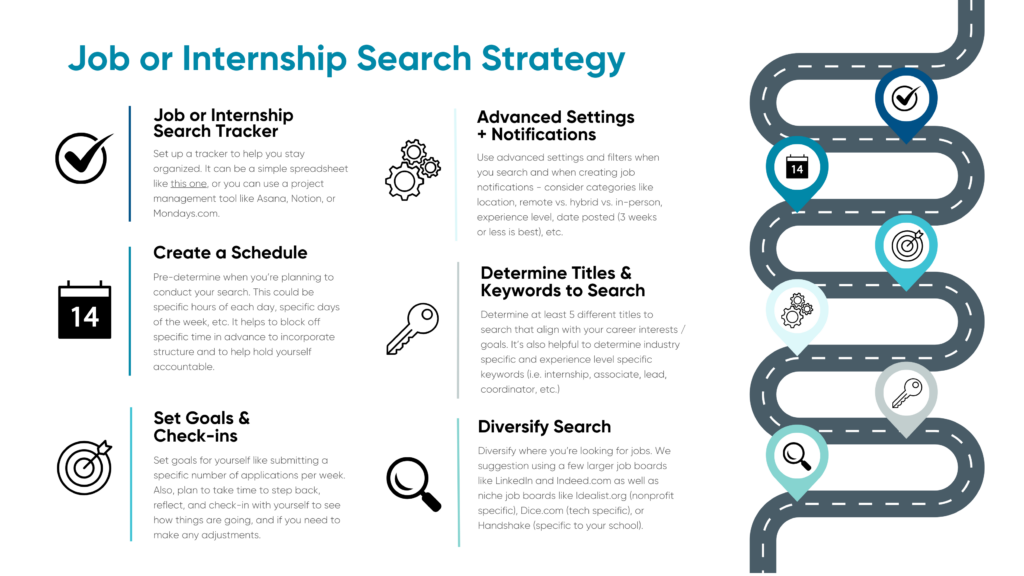
1. Use a job or internship search tracker
Whether you use a spreadsheet like this one, or project management tool like Notion, it’s important to front load how you plan to stay organized.
It can be greatly beneficial once you begin applying and interviewing for opportunities to track the status of your applications, see how many opportunities you’ve applied for, and (hopefully) feel less overwhelmed.
2. Create a schedule
Lean into what usually works for you! Think about how you typically study, prioritize, etc. And create a schedule based on that. Here are some suggestions for ways to approach creating a schedule for yourself:
- Block off your calendar. Dedicate specific hours each day to your job/internship search and block it off in your calendar.
- Set a schedule. Work on job/internship applications the same time every day like a job for a specific amount of time, like a job.
- Track deadlines. When available, add application due dates to your calendar to help you prioritize.
3. Set goals and check-ins
The job and internship search can feel overwhelming and monotonous at times. A way to mitigate feeling like a hamster on a wheel is to set short- and long-term goals. Use tools like SMART goals to help you define exactly what you’re trying to accomplish. Here’s an article to help you set job search goals.
Similarly, it’s advantageous to also schedule time to reflect. Take moments to think about what’s working, and what you might try to adjust. It doesn’t make sense to try to do the same thing repeatedly if you’re not getting the results you’re hoping for.
Take a “test and learn” approach and consider the following things to adjust as you go:
- Resume formatting – is it ATS friendly?
- Targeting – are your application materials targeted enough? (Think: quality over quantity)
- Position title – should you expand or narrow your search?
- Type of employer – should you consider different types of employers? (industry, size of company, etc.)
- Job post timing – try applying to positions within 2 weeks of them being posted
- Job boards – should you try looking somewhere new?
4. Use advanced settings and notifications
Most job search engines and platforms have adjustable settings to help narrow your search for both active searching within a platform and for job notifications.
- Be specific. If you’re looking for a marketing internship, it might help to search “SEO marketing internship” or “social media marketing” to ensure the opportunity aligns with what you’re looking for.
Notifications are also an easy lift – if you tailor your settings, it can do some of the searching for you by surfacing relevant opportunities.
- Use notifications. Notifications can be set within job search engines like LinkedIn and Indeed, or through the company directly (examples: Uber – Join Our Talent Network, Atlassian Talent Community, Salesforce Talent Community, Deloitte Talent Network, JPMC Talent Network).
5. Determine titles and keywords to search
Titles and keywords are usually distinct to specific industries. Do your research! You can ask Chat GPT, “what are some common entry level roles in the *insert field* field?” or “what are some common internship titles for someone interested in pursuing *insert type of work*?” For more ideas on job titles, check out this article.
6. Diversify your search
Your job search doesn’t have to be everything everywhere all at once, but it is encouraged to look in a few different places since not all employers use the same job boards to post their opportunities. You can also diversify your search by considering cross-industry roles as well, such as non-tech roles in tech, or non-healthcare roles in healthcare.
For example, IT is a technology related role, however IT positions exist outside of the tech industry – you could be an IT intern at a nonprofit or school or hospital. Similarly, you could be a marketing coordinator at a bank or tech company or laboratory.
Internship and job search tips
As you engage in your search, consider these tips to know what jobs you’re qualified for, how to sell your soft and transferable skills, to leverage your network, to schedule your time, and target your application materials.
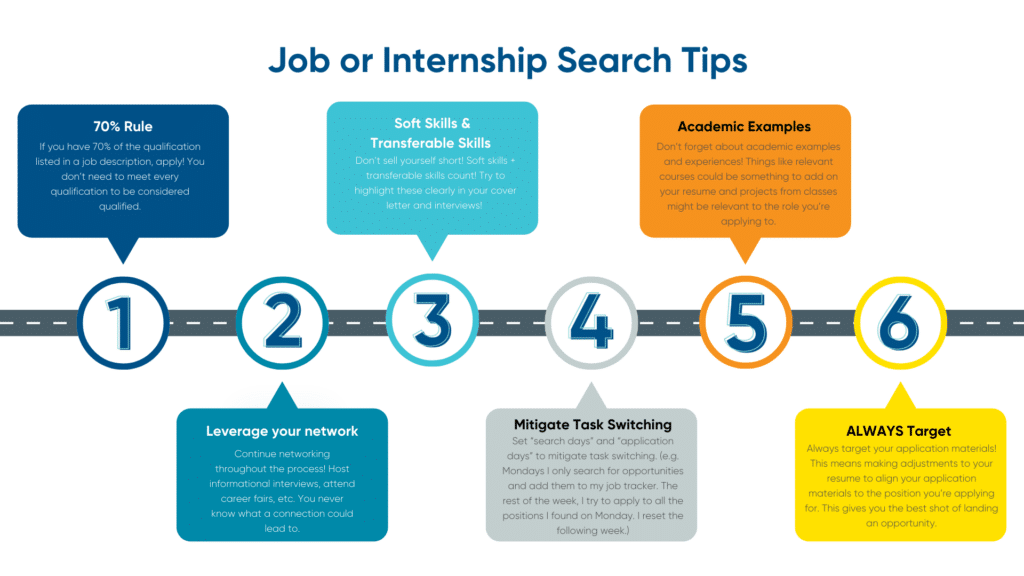
Other job and internship search resources
We’re here to help!
If you’re feeling unsure, would like extra eyes on your application materials, want help preparing for an interview, or just want a boost – we are here to help!
ABOUT MAKING WAVES Education FOUNDATION
At Making Waves, we are committed to educational equity. Making Waves Education Foundation is a Bay Area nonprofit that supports Making Waves Academy – a public charter school with more than 1,100 5th through 12th grade students – and leads college and career programming with more than 430 college students.
Knowing the opportunities that come with a college degree, we partner with historically underrepresented and underserved students to help make college affordable and graduation attainable. Centering the journeys of our students, our personalized approach includes college and career coaching, scholarships, and financial planning.
Our alumni network includes more than 730 college graduates, who earn their degrees and land jobs at more than twice the rate of their first-generation, low-income peers, with 85% graduating debt-free.
Related News and Resources
Your internship and job search roadmap
September 3, 2024
🎙️ Panel: What does belonging look like for Gen Z?
September 3, 2024
Eight reasons to do an internship while in college
September 3, 2024
How to set goals now to achieve your dreams in the future
September 3, 2024

